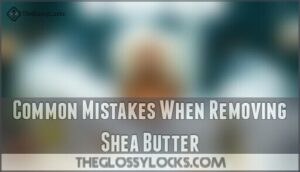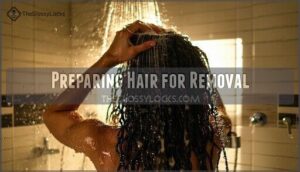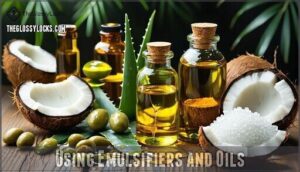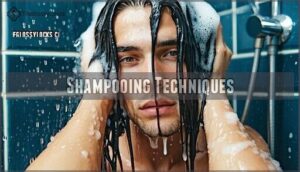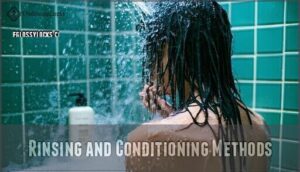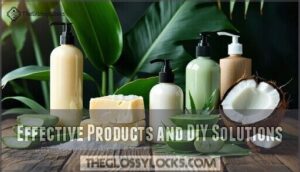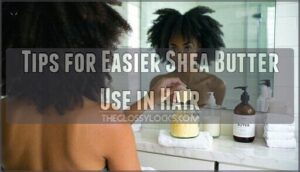This site is supported by our readers. We may earn a commission, at no cost to you, if you purchase through links.
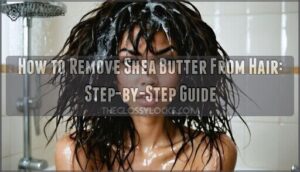
Here’s the problem: shea butter’s thick, waxy structure creates a hydrophobic barrier that water alone can’t penetrate. Your regular shampoo wasn’t designed to break down such heavy oils.
The good news? With the right emulsifiers and technique, you can remove shea butter from hair completely without stripping away your scalp’s natural protection or spending hours in the shower.
Table Of Contents
- Key Takeaways
- Why Shea Butter is Hard to Remove
- Common Mistakes When Removing Shea Butter
- Step-by-Step Guide to Remove Shea Butter From Hair
- Effective Products and DIY Solutions
- Tips for Easier Shea Butter Use in Hair
- Frequently Asked Questions (FAQs)
- How much Shea Butter should I use on my hair?
- Is Shea Butter suitable for all hair types?
- Are there any health risks associated with Shea Butter?
- Does Shea Butter help with dandruff?
- Can shea butter cause hair breakage or damage?
- How long does shea butter last in hair?
- Is shea butter safe for color-treated hair?
- Does shea butter work for all hair types?
- Can you sleep with shea butter in hair?
- Conclusion
Key Takeaways
- Shea butter resists removal because its thick, oil-based structure repels water, requiring emulsifiers (like oils or clarifying shampoos) to break down the waxy barrier instead of regular soap or water alone.
- The biggest mistakes include scrubbing too hard (which damages your scalp and pushes oil deeper), using plain soap (which can’t handle shea butter’s heavy composition), and over-toweling (which grinds residue into hair strands).
- The effective removal process involves pre-treating with oil to dissolve the butter, double-shampooing with clarifying products, and thorough warm-water rinsing followed by lightweight conditioning only on hair ends.
- Prevention beats cleanup—apply shea butter sparingly to damp (not soaking) hair, mix it with lighter oils for easier absorption, and run a clarifying shampoo routine monthly to avoid stubborn buildup.
Why Shea Butter is Hard to Remove
You’ve probably noticed that shea butter clings to your hair like it’s trying to become a permanent resident. That’s not your imagination—there’s real science behind why this natural moisturizer refuses to budge.
Let’s break down what makes shea butter so stubborn to remove.
Shea Butter’s Oily Composition
Shea butter is basically a solid oil—and that’s exactly why it clings to your hair like it’s trying to become a permanent resident. Packed with fatty acids, triglycerides, and vitamins A, D, and E, this oil-based product creates a rich barrier that locks in moisture.
The allantoin benefits are great for your scalp, but here’s the catch: all those oils don’t dissolve easily, making shea butter stubborn to remove from hair strands.
Oil and Water Interaction
You’ve probably heard "oil and water don’t mix"—and that’s precisely why your regular shampoo might fail you when you’re trying to wash out shea butter. Shea butter’s hydrophobic properties mean it repels water molecules like two magnets with the same charge.
Shea butter repels water like opposing magnets, which is why regular shampoo alone can’t break through its hydrophobic barrier
Without surfactants to break down the oil through emulsification, plain water just slides right off. That’s where the right cleansing products become non-negotiable for effective hair care.
Weather Effects on Removal
Weather throws a real wrench into shea butter removal. Humidity levels above 60% increase hair porosity, letting shea butter sink deeper and resist rinsing—you’ll need about two extra rinses compared to dry climates. Temperature impact matters too: heat melts shea butter, spreading it along your hair shaft, while cold hardens it stubbornly. UV exposure oxidizes the butter, making it cling tighter. Seasonal variability shows winter drops removal success by 15%.
Pollution effects compound the problem—airborne particles bind to shea butter, requiring clarifying treatments for oil-based products stuck in weather-exposed hair. High humidity can cause the scalp to produce excess sebum.
Common Mistakes When Removing Shea Butter
When you’re trying to get shea butter out of your hair, it’s easy to make things worse without realizing it.
A lot of people reach for the wrong products or use methods that seem logical but don’t actually work.
Let’s look at the most common mistakes so you can avoid the frustration and get better results.
Why Soap Alone Doesn’t Work
Your regular bar soap isn’t built to manage shea butter because soap works by grabbing onto both water and oil—but shea butter’s thick, waxy structure is too heavy for soap’s weak emulsifying power to manage on its own.
That’s why you end up doing multiple washes and still feel greasy residue buildup on your skin and hair. The oil-water barrier stays intact, and soap alone just can’t bridge that gap effectively for cleaning.
Scrubbing Risks and Skin Irritation
When you scrub hard to remove shea butter, you risk barrier disruption—your scalp can lose up to 20% of its moisture in a single session. Mechanical friction creates microtears 22% more often than gentle methods, opening doors for secondary infections like Staphylococcus aureus.
Chemical irritation follows when harsh cleansers hit abraded skin, spiking dryness by 35%. People with existing skin conditions face triple the irritation risk, and allergic reactions from shea butter compounds can jump 45% with aggressive scrubbing.
A study showed that cosmetic moisturizers can achieve good skin acceptability in women with sensitive skin.
Overusing Towels and Napkins
When you reach for that towel to wipe away shea butter, you’re actually grinding oil deeper into your hair shaft and triggering a cycle that makes removal three times harder.
Fiber contamination from wiping appliance material sticks to scalp hair, while the friction creates skin irritation without effective removal.
You’ll waste water, create hygiene concerns, and leave your hair care products fighting an uphill battle against that stubborn residue.
Step-by-Step Guide to Remove Shea Butter From Hair
Getting shea butter out of your hair doesn’t have to be a wrestling match with your shower drain. The key is working with the butter’s oily nature instead of fighting against it.
Here’s how to break down that stubborn residue and restore your hair to its clean, soft state.
Preparing Hair for Removal
Before you tackle the removal process, let’s get one thing straight: rushing in with harsh shampoo on dry, butter-laden hair is like trying to mop up oil with a dry towel—it won’t work.
Start with pre-removal hydration by wetting your scalp hair thoroughly with warm water. This softens the butter and gets your skin tissue ready for cleaner hygiene.
Next, gently detangle and section your hair to prevent breakage and make sure every strand gets proper attention during product selection.
Using Emulsifiers and Oils
Here’s the truth about removing shea butter: regular soap won’t cut it because oil and water don’t play nice together—you need an emulsifier to break down that greasy barrier.
Try oil cleansing with castor oil first—massage it into your hair to dissolve the shea butter.
For DIY blends, mix your chosen oil-based products with emulsifiers at proper ratios to help shea butter removal through effective emulsification.
Shampooing Techniques
Once you’ve loosened the shea butter with oil, it’s time to shampoo like you mean it—this is where you actually lift that stubborn residue out of your strands.
Apply shampoo directly to your scalp and work it through with firm circular motions—think scalp massage that actually gets the job done. Look for shampoos with clarifying ingredients or higher salt content since they break down oily residue better.
You’ll likely need two rounds of shampooing to fully remove shea butter from hair, so don’t skip that second wash.
Rinsing and Conditioning Methods
After all that shampooing, thorough rinsing is what stands between you and truly clean hair—skip it, and you’re just moving greasy residue around. Here’s how to rinse properly after removing shea butter and other oil-based products:
- Use warm water first – Rinse temperature matters since warm water helps break down remaining oily ingredients better than cold.
- Apply lightweight conditioner mid-shaft to ends – Avoid your scalp to prevent product buildup while supporting scalp health.
- Detangle gently during the detangling process – Work through knots while conditioner provides slip.
- Finish with cool water – Seals cuticles and removes any lingering hair anointing material from your shampoo routine.
Effective Products and DIY Solutions
You’ve got options for removing shea butter from your hair. Some products work better than others, and you can even make your own solutions at home.
Let’s look at what actually works to break down that stubborn oily residue.
Best Shampoos for Oily Residue
Clarifying shampoos work wonders on stubborn oily residue because they target buildup with powerful surfactant ingredients. Sulfate shampoos lift shea butter efficiently, though you’ll want to alternate with gentler formulations for scalp health.
Look for botanical extracts like tea tree or peppermint—they dissolve oil-based products while invigorating your skin.
User preferences lean toward shampoos combining clarifying ingredients with hydrating agents, preventing that stripped, dry feeling after removal.
Liquid Soaps and Salty Cleansers
Salt-based liquid soaps cut through shea butter’s waxy grip better than bar soap ever could—the high sodium content breaks down oils on contact.
Here’s what works:
- Salty shampoo: Naturally emulsifies oils without harsh scrubbing
- Liquid soap solutions: Apply directly to hair before water for maximum effectiveness
- Hand palm cleaning: Use circular motions with concentrated liquid soap
- Skin hygiene balance: Limit use to prevent dryness from excessive salt exposure
These soap application methods respect your scalp while tackling stubborn residue.
Homemade Emulsifier Mixes
You can whip up your own emulsifier blend at home using ingredients that turn shea butter from a clingy nightmare into something that rinses clean.
Mix hydrogenated castor oil with water at a 1:3 ratio to create a simple emulsifier that breaks down oil-based products on contact.
Apply this DIY body butter recipe directly to your hair, massage through the shea butter buildup, then rinse—it cuts through waxy residue without harsh scrubbing.
Commercial Alternatives to Pure Shea Butter
If mixing your own emulsifier feels like too much work, commercial products offer easier solutions. Market growth in plant-based alternatives means you’ll find skincare-friendly moisturizer options everywhere—cocoa butter, mango butter, and argan oil blends absorb faster than pure shea. These oil-based products include built-in emulsifiers for topical application that actually rinses out:
- Cocoa butter for smoother, less sticky after-feel
- Argan oil formulas for lightweight, fast absorption
- Moringa butter blends with low odor and refined texture
- Vegan-certified alternatives meeting ingredient safety standards
- Custom solutions targeting your specific hair type
Environmental impact matters too—look for RSPO-certified options with transparent sourcing.
Tips for Easier Shea Butter Use in Hair
The key to loving shea butter without the cleanup headache is using it the right way from the start.
Smart application and mixing techniques can prevent most removal problems before they happen.
Here’s how to make shea butter work with your hair instead of against it.
Proper Application Techniques
The secret to easy shea butter removal starts long before you ever reach for shampoo—it’s all about how you apply it in the first place.
Start with pre-application prep: work with damp hair, not soaking wet. This helps the moisturizer spread evenly without clumping. Use layering methods—apply thin coats instead of thick globs. Focus on scalp coverage sparingly since heavy topical application there creates the worst buildup.
Warm the butter between your palms first for even application and better hydration without overdoing it.
Combining Shea Butter With Other Products
If you want shea butter’s benefits without the hassle, blending it with lighter ingredients transforms it into something your hair can actually absorb—and relish.
DIY Shea Blends that work:
- Mix shea with jojoba or grapeseed oil for creamy combinations that rinse easier
- Blend equal parts shea and mango butter for lighter body butter consistency
- Create oil infusions by melting shea with coconut oil at 3:1 ratio
- Try product layering—apply leave-in conditioner first, then shea as a sealant
This hair masking approach gives you moisture without the sticky aftermath.
Reducing Stickiness and Build-Up
Keeping shea butter lightweight from the start beats wrestling with greasy buildup later—here’s how to sidestep the sticky mess altogether. Apply less than you think you need—a dime-sized amount covers most hair lengths.
Dilution methods work wonders: warm shea between your palms with a few drops of lighter oil before touching your scalp. Space applications to twice weekly max, and run clarifying routines monthly to reset your strands.
Your scalp health depends on breathing room, not suffocation.
Preventing Future Removal Challenges
Smart adjustments before application save you hours of cleanup frustration down the road. Test lighter alternatives like whipped butter blends that rinse faster than pure shea. Pre-application prep matters—dampen hair slightly so oil-based products spread thinner.
Watch your application amount and skip product layering when weather conditions turn humid. Regular cleansing with clarifying shampoo prevents buildup from cementing onto your skin and strands, keeping oil and water interaction balanced.
Frequently Asked Questions (FAQs)
How much Shea Butter should I use on my hair?
Dime-sized portions work for most people, but hair thickness matters more than you think. Fine hair needs less butter since it absorbs faster.
Thick or high-porosity hair tolerates more product without feeling greasy, especially in cold weather conditions.
Is Shea Butter suitable for all hair types?
Shea butter works well for most hair types but shines on coarse, thick, or curly strands. Fine hair can feel weighed down since this vegan butter is so rich and oil-based.
Check your porosity levels first—high-porosity hair absorbs it beautifully, while low-porosity hair may struggle with buildup.
Are there any health risks associated with Shea Butter?
Most people tolerate this vegan butter well, but allergic reactions can occur—especially with tree nut sensitivities.
Skin sensitivity and comedogenic potential exist, particularly for acne-prone individuals.
Always patch-test oil-based products and verify your shea source to avoid contamination risks.
Does Shea Butter help with dandruff?
Flaky frustration meets fatty friend—shea butter can help with dandruff. It addresses Scalp Inflammation and Skin moisturization while addressing Dandruff Causes like dryness.
The butter creates a protective barrier, reducing irritation and supporting a healthier scalp environment when applied correctly.
Can shea butter cause hair breakage or damage?
When used correctly, shea butter won’t cause breakage or damage. Problems happen when you apply too much or layer oil-based products like cocoa butter without proper cleansing, leading to buildup that weighs hair down and creates breakage risk factors.
How long does shea butter last in hair?
Most hair types retain shea butter’s benefits for two to three days, depending on hair porosity and application frequency. Environmental factors like humidity extend its presence, while oil-based products layer differently than cocoa butter or body butter formulations.
Is shea butter safe for color-treated hair?
Yes, shea butter is safe for color-treated hair. This oil-based product won’t strip dye or cause color fading.
It actually helps maintain moisture balance without chemical interactions that damage treated strands.
Does shea butter work for all hair types?
Works for most types, but results vary by porosity levels and hair texture. Low porosity hair struggles with heavy butter absorption, while high porosity benefits from its occlusive properties. Always perform sensitivity tests before full application.
Can you sleep with shea butter in hair?
Absolutely. Overnight Shea Benefits include deep moisture absorption while you rest. Your hair drinks up those oil-based products slowly, improving Scalp Health Impact.
Just wrap your hair or use Pillowcase Protection to avoid greasy sheets—body butter transfers easily.
Conclusion
Don’t let shea butter leave you in a sticky situation. The secret to removing shea butter from hair isn’t about scrubbing harder—it’s about working smarter with emulsifiers that break down those waxy bonds.
Whether you reach for a clarifying shampoo or whip up a DIY oil-based pre-treatment, you now have the knowledge to restore your hair’s natural bounce.
Remember: the right technique transforms a frustrating hair day into a quick fix. Your strands deserve that freedom.
- https://blog.leona.co/about-us/
- https://www.kktconsultants.com/resume
- https://www.ncbi.nlm.nih.gov/pmc/articles/PMC5796020/
- https://www.cliqueorganicsalons.com/blog/how-humidity-affects-your-hair-and-what-to-do-about-it
- http://www.soaplabmalaysia.com/2019/01/how-to-remove-shea-butter-from-skin-hair.html

